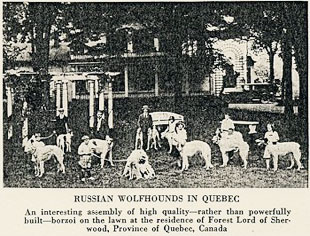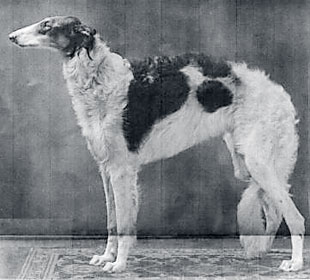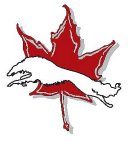General History of the Breed
The Borzoi, named for the Russian word meaning "swift", is a noble breed with a long and colourful history. The breed originated in Russia and was closely associated with the aristocracy. The favoured sport of the Russian nobility was hunting, most especially wolves, and what is known as that the Borzoi was developed to meet the demands required for coursing. Thus the Borzoi became renowned for its speed, agility, strength, endurance and courage.
The earliest recorded written Standard for the Borzoi is 1650. However, much of the popular, or more well-known history pertaining to the Borzoi stems from the great kennel Perchina owned by the Grand Duke Nickolai Nikolaievitch circa 1887. Another very influential Russian kennel from that same era was Woronzova owned by Mr. Artem Balderoff. In North America today, a number of well-known kennels can trace their lineage to these famous kennels of the last century largely because of the efforts of Joseph Thomas who imported a number of Borzoi from these famous kennels into America and founded the O'Valley Farm Borzoi.
It is interesting to note that the Borzoi was first registered in Canada in 1892 and since that time, a number of Canadian bred Borzoi have contributed significantly to the success of the breed in Canada as well as abroad.
Our publications area contains the titles of several books on the history of the Borzoi and the reading is excellent.
BIS Ch. Peterhoff of Marlboro
The following article was submitted by Judy Carleton, (Elista Borzoi) as a rare glimpse into the history of Borzoi In Canada. Many thanks to Judy for providing this article. It is important to us as both a National breed club and breeders of this noble hound to share any stories and photos of past events.
BIS Ch. Peterhoff of Marlboro was bred at Marlboro kennels in Halifax, N.S. by Mr. Maurice B. Zwicker. Mr. Zwicker had imported his foundation stock from the English Haywra and Shay kennels. In 1930 Peterhoff won two Best in Shows, one at Halifax and one at the St. John, New Brunswick shows. It was said that he later was shown in the eastern states where he attained his American championship, but was poisoned at a show and was brought home, and not expected to live. However, he did pull through and was never shown again. Mr. Zwicker trained his Borzoi for sled work, a sport not many did with Borzoi.
In an article written in 1932 by Freeman Lloyd called "Russian Wolfhounds of Yesterday and Today", Mr. Lloyd wrote about Peterhoff as follows - " Among the Russian wolfhounds observed on the North American continent have been the large, quality-possessing borzoi bred and owned in the Dominion of Canada. Among those was a dog at Halifax, Nova Scotia, and at St. John, New Brunswick, shows during the fall of 1930. I had heard of the measurements of Ch. Peterhoff of Marlboro, which won as best in show at both the above exhibitions, but to make sure of the height, weight, and so on of this borzoi, Maurice B. Zwicker of Halifax, breeder and owner of Peterhoff, was asked to supply a sworn statement regarding the measurements, etc., of his sound, large borzoi, possessed of that necessary "quality," a term that is so difficult to describe. For "quality," even in a dog, might be confused with "effeminate" - certainly a drawback in a dog employed for European wolf or American timber wolf hunting.
Borzoi in Quebec

(Photo courtesy of Judy Carleton, Elista Borzoi)

Complying with the request, Mr. Zwicker, on October 23, 1931, swore to the following affadavit before Carl P. Bethune, notary public of the Province of Nova Scotia. The figures refer to Ch. Peterhof of Marlboro.The following are the official measurements taken October 15, 1931:
Length of head, from nose to occiput, 13½ inches
Height at the shoulder, 34 inches (under standard)
Girth, back of forelegs, 37½ inches
Weight, 102½ pounds
Here will be found a matter of considerable interest - one that undoubtedly will have its international value as a scale for reference or making comparisons. As it is remembered, the hair at the end of this dog's tail, while in repose, touched the level ground on which he stood. Peterhoff came from a long line of Russian or continental European-bred borzoi. This Canadian champion is not a dish-faced specimen of this breed."
Early Registration Data
Borzoi were introduced to Canada in 1891 with 2 being imported. The following are years with registration numbers.
1897 - 1 |
1906 - 5 |
1913 -25 |
1898 - 4 |
1907 - 7 |
1914 - 41 |
1900 - 5 |
1908 - 7 |
1915 - 10 |
1901 - 5 |
1909 - 8 |
1916 - 54 |
1902 - 9 |
1910 - 21 |
1917 - 62 |
1903 - 7 |
1911 - 17 |
1918 - 63 |
1904 - 1 |
1912 - 29 |
1919 - 85 |
1905 - 0 |
